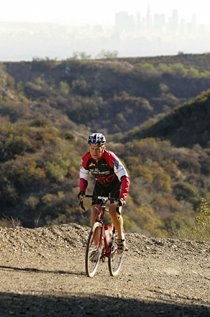 L-R: Harry Winand, Gene Oberpriller, John Stamstad, Chris Kostman at the 24 Hours of Canaan
L-R: Harry Winand, Gene Oberpriller, John Stamstad, Chris Kostman at the 24 Hours of Canaanwith our Bridgestone XO-1 bikes: neither road bike, nor mountain bikes. Rough Stuff bikes!
Any Bike, Anywhere
By Chris Kostman
By Chris Kostman
Bikes are the ultimate freedom tools: they let you go to more places, more easily, and more simply than any other human invention. But in today’s era of high technology and equipment specialization, they can also seem incredibly limiting. In fact, it’s a common misconception that without the "right bike," one simply cannot partake in the wonderful landscape of cycling opportunities. It’s time to set the record straight, though, for any bike can be taken anywhere!
This really isn’t some secret conspiracy that I am blowing the whistle on here, for cyclists the world round take "the wrong bike into the wrong place." Just ride any century ride and you’ll see innumerable mountain bikes and cross bikes being comfortably and happily put to good use in grinding out the 100 miler. (Heck, mountain bikes have even been ridden successfully in 500 mile road races!) And trails have been ridden for over a century on skinny-tyred bikes, both before and since the inception of the "all-terrain bike." And not only do some of us ride off-pavement with road bikes, but we do it well enough to leave plenty of hi-tech fat tyre bikes in the dust in the process.
How does all this work, you ask? It’s simply a case of the rider riding the bike, not the reverse. In other words, let technology work for you or just don’t use the technology in the first place. Think about it: turning cranks in circles is turning cranks in circles. Whether that translates into covering terrain efficiently is entirely up to the skill and strength of the rider. With time, any rider can learn to ride any bike anywhere. The trick is just getting out there and going for it!
This philosophy can mean different things to different people. First of all, it can mean that you may not really have to shell out the bucks for a new bike because you only have a "road bike" or a "mountain bike." So this can save you a lot of money. But if you already have both types of bikes, then you can hone your skills for either bike by using the "wrong bike" on various rides.
Riding skinny tyres off-pavement will hone your attentiveness, balance, coordination, handling skills, and nerve. Riding fat tyres on-road will build strength, hill climbing ability, and provide a comfy and largely bullet-proof ride. Rides that combine both environments will become a real treat, allowing you to immediately experience the cross-over benefits firsthand.
Yet more reasons exist for taking any bike anywhere… Your potential riding world will become exponentially bigger and more diverse every time you venture out, for you’ll stop differentiating between road rides and trail rides. Thus your new approach to the sport will yield innumerable new adventures and exciting outdoor opportunities. This will translate into a more energetic and purposeful lifestyle that seeks to find and follow the path, no matter how seemingly arduous, that leads to your chosen destination. You’ll learn not to be swayed and diverted by what others think or do, but will stick to your guns, whatever they may be. Your bike will become not only a fitness tool, but a vehicle for self-empowerment!
This really isn’t some secret conspiracy that I am blowing the whistle on here, for cyclists the world round take "the wrong bike into the wrong place." Just ride any century ride and you’ll see innumerable mountain bikes and cross bikes being comfortably and happily put to good use in grinding out the 100 miler. (Heck, mountain bikes have even been ridden successfully in 500 mile road races!) And trails have been ridden for over a century on skinny-tyred bikes, both before and since the inception of the "all-terrain bike." And not only do some of us ride off-pavement with road bikes, but we do it well enough to leave plenty of hi-tech fat tyre bikes in the dust in the process.
How does all this work, you ask? It’s simply a case of the rider riding the bike, not the reverse. In other words, let technology work for you or just don’t use the technology in the first place. Think about it: turning cranks in circles is turning cranks in circles. Whether that translates into covering terrain efficiently is entirely up to the skill and strength of the rider. With time, any rider can learn to ride any bike anywhere. The trick is just getting out there and going for it!
This philosophy can mean different things to different people. First of all, it can mean that you may not really have to shell out the bucks for a new bike because you only have a "road bike" or a "mountain bike." So this can save you a lot of money. But if you already have both types of bikes, then you can hone your skills for either bike by using the "wrong bike" on various rides.
Riding skinny tyres off-pavement will hone your attentiveness, balance, coordination, handling skills, and nerve. Riding fat tyres on-road will build strength, hill climbing ability, and provide a comfy and largely bullet-proof ride. Rides that combine both environments will become a real treat, allowing you to immediately experience the cross-over benefits firsthand.
Yet more reasons exist for taking any bike anywhere… Your potential riding world will become exponentially bigger and more diverse every time you venture out, for you’ll stop differentiating between road rides and trail rides. Thus your new approach to the sport will yield innumerable new adventures and exciting outdoor opportunities. This will translate into a more energetic and purposeful lifestyle that seeks to find and follow the path, no matter how seemingly arduous, that leads to your chosen destination. You’ll learn not to be swayed and diverted by what others think or do, but will stick to your guns, whatever they may be. Your bike will become not only a fitness tool, but a vehicle for self-empowerment!
Streetify Your ATB
If you want to ride your "all-terrain bike" predominantly on the pavement, then some roadifying modifications might be in order:
Narrow, hi pressure tyes: Specialized ATB/S 1" or Fat Boy 1.25", Avocet Tri-Cross 1.25", or Ritchey Cross Bite 1.1".
Taller Gearing: tighter spaced cogset, such as an 11-24, and/or bigger chainrings, such as 36-42-54.
Multi-position handlebars and/or an aero clip-on handlebar.
Really trick modifications include lighter, more aerodynamic wheels and clipless road pedals and shoes.
Narrow, hi pressure tyes: Specialized ATB/S 1" or Fat Boy 1.25", Avocet Tri-Cross 1.25", or Ritchey Cross Bite 1.1".
Taller Gearing: tighter spaced cogset, such as an 11-24, and/or bigger chainrings, such as 36-42-54.
Multi-position handlebars and/or an aero clip-on handlebar.
Really trick modifications include lighter, more aerodynamic wheels and clipless road pedals and shoes.
The degree of modification made to a road bike for trail riding will affect its durability and need of service, as well as the amount of technique you’ll need to invest in it. The basics include:
Bar end shifters to shift from the bars, and maybe a double wrap of tape to add some cushion for your hands.
Slightly wider tyres: 28mm, ideally with some sort of inverted tread, such as the Ritchey Road Force Kevlar.
Slightly lower gearing: low gear of 39x26, for example.
To get more trail-specific, consider:
Knobby tyres up to 35, 38, even 45mm, whatever will fit inside your fork and frame.
Triple crank gearing: low gear of 24x28 perhaps.
Cantilever brakes for maximum stopping power. (This requires adding braze-ons to your frame or the clamp-on Moots Mounts.)
Originally published in City Sports, May 1993, then in the 1994 Bridgestone Cycle USA Catalogue.
Bar end shifters to shift from the bars, and maybe a double wrap of tape to add some cushion for your hands.
Slightly wider tyres: 28mm, ideally with some sort of inverted tread, such as the Ritchey Road Force Kevlar.
Slightly lower gearing: low gear of 39x26, for example.
To get more trail-specific, consider:
Knobby tyres up to 35, 38, even 45mm, whatever will fit inside your fork and frame.
Triple crank gearing: low gear of 24x28 perhaps.
Cantilever brakes for maximum stopping power. (This requires adding braze-ons to your frame or the clamp-on Moots Mounts.)
Originally published in City Sports, May 1993, then in the 1994 Bridgestone Cycle USA Catalogue.


























No comments:
Post a Comment